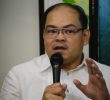DAVAO CITY – Expect longer brownouts that would last from four to six hours in a day.
This was announced by Davao Light and Power Company (DLPC) Senior Vice President Art Milan in a press conference Wednesday at the Marco Polo Hotel.
Milan said starting last April 28, the scheduled power outage will increase from one hour a day to a maximum of two and a half hours, but would possibility reach up to four hours due to the much lower supply coming from the Mindanao Grid of the National Grid Corporation of the Philippines (NGCP).
Milan said NGCP announced that low water elevation from the National Power Corporation’s (Napocor) Agus 2, 4, 6 and Pulangi 4 hydro-electric power plants had reduced its supply allocation of power to DLPC and other electric utilities.
“Pulangi is not operating any longer, and Agus’ water level is at critical level,” said Milan.
Milan said with the low power supply, they have to resort to rotational brownouts among the cluster feeders.
Outages during peak hours from 9 am to 9 pm would last up to four hours, while an additional two hours of outage are scheduled during off-peak hours at night.
Since Monday, residents and business establishments have been surprised and irate that brownouts have ranged from two to three hours, saying businesses have been affected.
Milan apologized to the public for the inconvenience, saying the dry summer and the maintenance shutdown of two coal fired power plants from STEAG had resulted to a lower level of power supply.
“We just have to face the complaints. Actually at the end of the day, we too go home to face the same situation of brownouts with our families,” said Milan.
He assured that vital institutions such as the Davao City Water District, Davao International Airport, Central 911 and hospitals will be prioritized with power supply by the Davao Light.
DLPC Vice President Rodger Velasco added that changes in the weather are something that they can’t forecast, thus the supply of power from Napocor changes every day.
Milan said Davao City’s peak demand now at summer is at 330 mega-watts (MW) but the reduced supply has limited Davao Light’s capacity to generate up to 260 MW.
“We have a contracted supply of 360 MW, of which 280MW comes from Napocor, but they can only give us 120 MW,” said Milan.
He said Davao Light has to rely on its own supply coming from the Aboitiz-owned Hedcor and Therma South; in addition to its standby plant at Bajada which can produce a total of 116 MW. But he said he is concerned that the Davao Light plant at Bajada might give out as it has continually provided standby power with no breaks.
Milan said he is hoping that the restoration of the STEAG units, one expected on May 5 and the other in June 5, will provide additional power supply of 100 MW, and restore power supply to Davao City by June.
Milan assured Davao Light consumers there would be no additional charges in the power bill as the generation charge will still range around P3.80 to P 4.20 per kilowatt/hour.
He said the NGCP’s power grid in Mindanao has a maximum supply of 720 MW, but is now producing at around 420 MW distributed to various power utilities.
Meanwhile, the activist group Bagong Alyansang Makabayan Southern Mindanao criticized Davao Light’s action as a justification to shift from hydro-power to coal-fired power.
“Their apology is not accepted and their line of reasoning will never be justifiable. Aboitiz and Henry Sy Jr (NGCP President) is doing this to justify coal fired powered plants and privatization of Agus Pulangi hydro power plant,” said Sheena Duazo, spokesperson of Bayan SMR.
Milan said that the Therma South’s coal-fired power plant in Toril will give an additional 50 MW but this will be on March 2015 next year.
But Bayan said this scheme fits the Aquino government’s private-public partnership at the expense of the consumers.
“Instead of rehabilitating existing power plants such as the Agus-Pulangi complex and maximizing power barges, the Aquino government resorted to privatization under its PPP. Now, two power barges are sold to the Aboitiz at a cheap price,” said Duazo.
In the Mindanao Power Summit held in 2012, President Benigno Aquino III has said that those who demand for more electricity must pay the price.(davaotoday.com)










